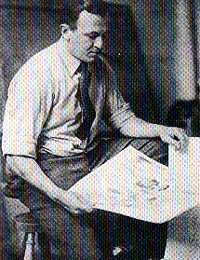GermanExpressionism.com >> Artist Index >> George Grosz Biography
1893-1959

View a selection of George Grosz Prints
George Grosz was born in Berlin in 1893. He attended the Dresden Academy of Arts from 1909 to 1911, followed by a year at the School of Arts and Crafts in Berlin and a visit to Paris in 1913. After his release from a short period of military service in 1915, Grosz met the Communist writer Wieland Herzfelde whose publishing company brought out Grosz's first two folios of lithographs in 1917. After his readmission to the army in 1917, he underwent psychiatric treatment. In 1918 he joined the Communist party, and in 1919 became a leading contributor to the Berlin Dada movement. Between 1919 and 1923 Grosz produced his most caustic portrayals of contemporary society and from 1923 to 1927 he worked for the Communist weekly paper Der Rote Knuppel (The Red Cudgel). In 1925 he was one of the dominant artists in the Neue Sachlichkeit (New Objectivity) exhibition in Mannheim. In 1933, Grosz emigrated to the United States where he remained until his return to Berlin in 1959. He died the same year.
The novelist, Elias Canetti, described the ambiguities of Grosz's character as "on the one hand a revered political and social satirist, who dressed like a nautical American and behaved with open-handed generosity and on the other hand a drunken, lecherous dandy and an abusive guest at a party who was transformed into one of the loathsome characters in his drawings."
Apart from a few early etchings from 1912-14 and another later group from 1939 and 1949, most of the prints made by Grosz were photolithographic facsimiles of drawings. His main concern was not original printmaking but the accessibility of his work to the widest possible audience.